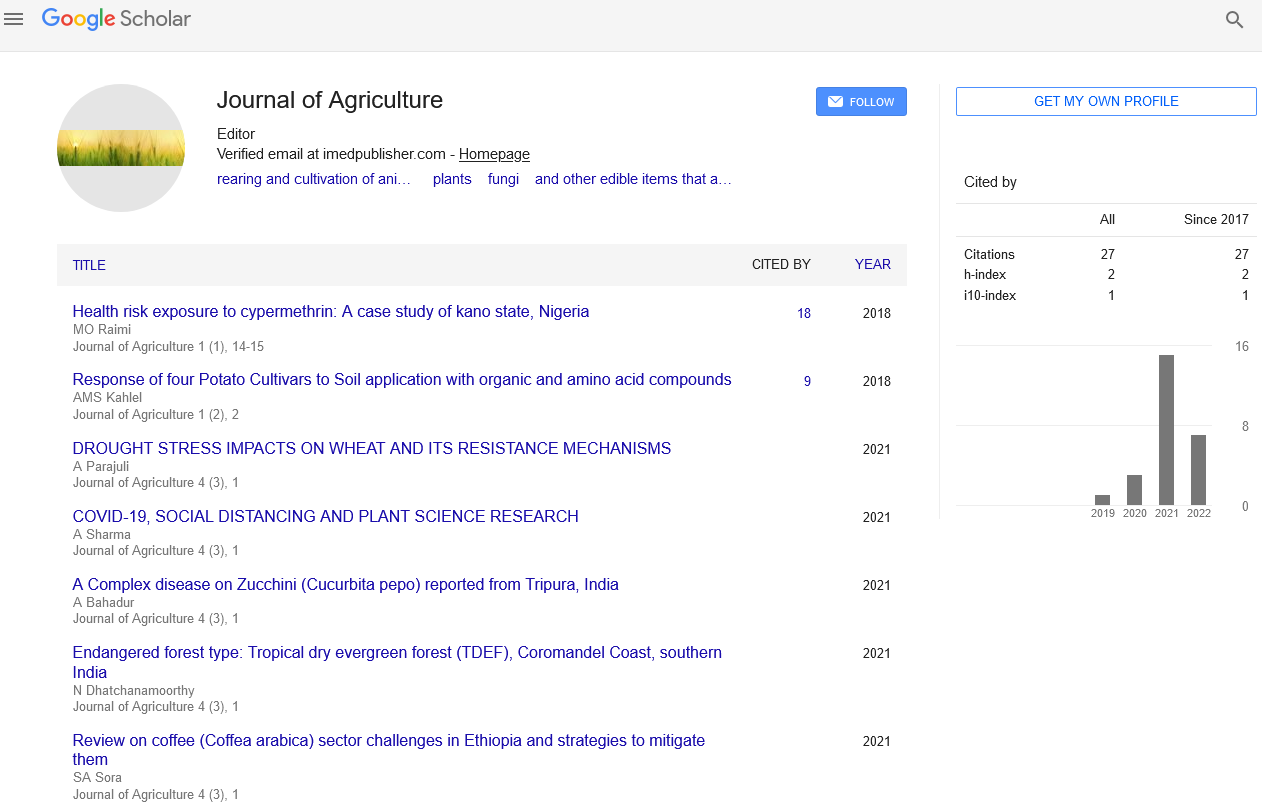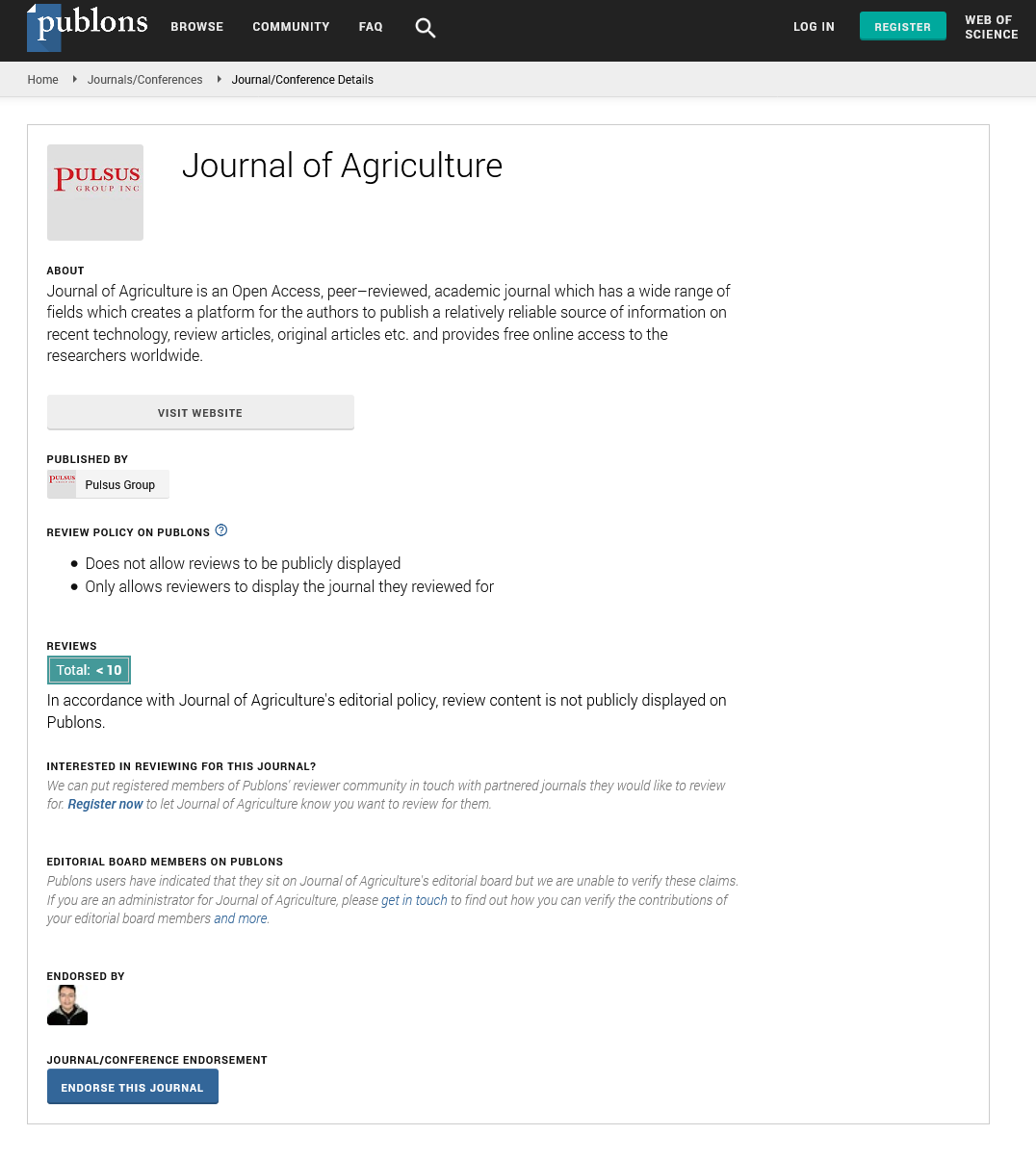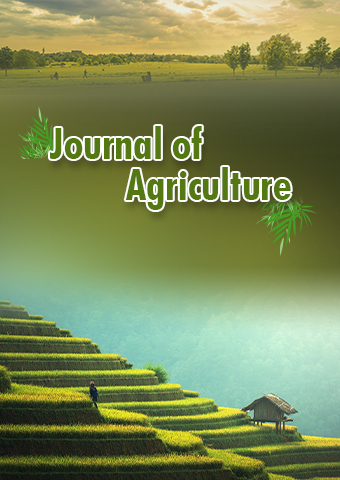Mini Review - Journal of Agriculture (2023) Volume 6, Issue 4
A Distinctive Cultivation Compiler Converts the Agricultural Preparation
- Corresponding Author:
- Sunirmal Giri
Department of Agriculture, Anand Agricultural University, Gujarat, India
E-mail: giridrsunirmal@gmail.com
Received: 23-Jan-2023, Manuscript No. JAGRI-23-87730; Editor assigned: 26-Jan-2023, Pre-QC No. JAGRI-23-87730 (PQ); Reviewed: 10- Feb-2023, QC No. JAGRI-23-87730; Revised: 25-Jul-2023, Manuscript No. JAGRI-23-87730 (R); Published: 01-Aug-2023, DOI: 10.37532/JAGRI.2023.6(4).94-97
Abstract
Different soil vegetation conditions combined with irrigation management and/or agricultural production systems can affect soil moisture content and crop yield. This study investigated the effects of agricultural production systems and pivot irrigation management on soil moisture content during off-season cultivation of soybean and maize crops. During the 2018-2019 growing season, he performed two field trials under tropical Cerrado soil conditions. One experiment consisted of applying three irrigation water depths (0%, 50%, and 100% of crop evaporation) during soybean cultivation in a no-till system under Ruzigras (Urochloa ruziziensis) straw, the second experiment consisted of mixed or unmixed. Cultivation of maize hybrids with rugegras in agricultural areas with and without the influence of Eucalyptus plantations. Soil volumetric moisture was measured using an electronic soil moisture meter (Hidrofarm) to determine the mass and yield of 1000 soybean and maize grains in two experiments. Irrigation and no-tillage did not affect soybean yield. Soybean cultivars NA 5909 RG and TMG 7067 IPRO exhibited a TGM of over 180 g. This corresponds to a TGM that is on average 22% higher than the BMX DESAFIO RR and CD 2737 RR. The presence of Eucalyptus forests increased maize soil moisture by 1.5%. Soil management systems such as irrigation use cover crops that may not increase productivity as expected for soybeans and maize.
Keywords
Irrigation management • Moisture soil sensor • Cultivars • Vegetation • Agricultural
Introduction
Agricultural production in the Cerrado region is a major driver of the Brazilian economy and agribusiness. Grain production forecasts for the next 10 years show that Brazil’s grain production will reach 320 million tons, an increase of 25.5% from the current 255 million tons. However, this increase in grain production is due to the adoption of techniques and management practices developed for the Brazilian agricultural system [1].
The agricultural areas of the Cerrado region are ideal for the development of Brazilian agricultural production. This is mainly due to the favorable tropical climate and soils with good physical properties that facilitate mechanized operations and agricultural practices. However, crop yields in the Cerrado were often affected by lack of rainfall and severe drought during cultivation. Drought and persistent lack of rainfall are now major natural problems that threaten food and water security in large areas of the world’s agriculture.
Irrigation is a technique that can reduce the negative impact of wet season drought on crop yields. In addition, irrigation can also enhance agricultural land utilization and increase agricultural yields by enabling grain production during the dry season in the Cerrado region. However, the use of irrigation requires a high level of capital investment and professional technical support by farmers to ensure reasonable water use and sustainable crop production.
Soil moisture balance helps determine the watering needs of plants and improves the management of irrigation systems. Therefore, sustainable irrigation management requires knowledge of soil water availability and soil water storage capacity during the developmental stages of crops. A practical and simple alternative to measuring crop soil moisture is to use a tensiometer or soil moisture sensor. Soil moisture sensors used in the field detect soil moisture with high accuracy regardless of environmental changes and dry and wet seasons. Using a soil moisture sensor can reduce water loss from the soil, making it efficient fo r ir rigation pr ogramming. Us ed soil moisture sensors and observed that cover crops improved soil moisture retention in cash crops compared to no cover crops. In addition to irrigation, the introduction of agricultural conservation systems such as the agroforestry system “AFS”. It can also improve the production environment and grain yields for major crops in the Cerrado region. Widespread in Brazil, AFS is characterized by land use management that grows trees in combination with crops. This production system is an excellent alternative for sustainable and competitive agricultural development, especially for improving soil physical, chemical and biological properties and mitigating the impact of intensive land use is regarded. However, the water demand of trees is greater than that of crops, which depends on the amount of tree cover established. There is no evidence that water content in plants can be limited [2,3].
Literature Review
The overall performance of sustainable agricultural production systems depends on large amounts of straw fed through the soil surface. This can be achieved by growing field crops in intercrops with cover crops. The main crop used in the no-till system in the Cerrado region is soybean (Glycine max (L.) Merrill). Maize (Zea mays L, tropical grasses of the genus Urochloa sp. It can also be grown as a mixture with a wide variety of forest species, including Eucalyptus (Eucalyptus spp.).
Balancing (storage/discharge) of C in different cultivation systems is more common in the Cerrado than in other biomes. We evaluated C stocks in different cropping systems in the Cerrado biome and found that pastures had much more C (260 Mg ha-1) than Eucalyptus plantations (174 Mg ha-1 m-1) and native vegetation (167 Mg ha-1). Observed to accumulate ha-1 m-1)-1m-1). Additionally, the AFS system improves soil structure conditions. This promotes most water infiltration into the s oil, reduces surface runoff, and prevents erosion and contamination of surface water sources. This increase in the rate of water penetration into the soil profile leads to the development of larger and deeper roots, increasing the tillage explored by the root system and increasing the efficiency of wa ter and nu trient us e by crops. In the Cerrado, the assessed effects of cropping systems on soil moisture and crop yield have been largely unstudied [4].
In Brazil, the location occupied through the corn crop with inside the 2021/2022 harvest turned into 17.25 million hectares cultivated all through the primary harvest (spring–summer time season), that’s sown from September to December and harvested from January to April, and the second one harvest (fall–iciness), that’s sown from January to March and harvested from May to August. The low season corn planted with inside the summer time season and harvested with inside the fall/iciness occupies 71.6% of the location and has a mean grain yield of about 5857 kg ha-1 [5]. Thus, maximum corn is grown with inside the low season.
The excessive straw persistence, excessive dry remember manufacturing, properly weed suppression performance and competitive and deep roots are feature of Urochloa, that’s why they may be used as cowl vegetation with inside the Brazilian Cerrado, and furthermore, ruzigrass promotes nutrient biking specially of N.
These studies aimed to assess modifications in soil moisture content material all through the cultivation of soybean and low season corn vegetation subjected to specific s oil control systems.
In one study, we investigated the impact of middle pivot irrigation control at the soil moisture and yield of soybean grown with inside the no-tillage gadget beneath ruzigrass (Urochloa ruziziensis) straw, and in some other experiment, we evaluated the impact of intercropped and non-inter cropped cultivation of corn with ruzigrass in an agricultural location with and without the have an impact on of Eucalyptus reforestation at the soil moisture content material and yield of the low season corn crop. Our speculation is that grain yield, 1000 grain mass manufacturing and soil moisture rely upon the drought strain going on all through cultivation no matter the form of soil control used.
Results
Soil moisture content and grain yield
Harvest time and irrigation management significantly a ffected so il mo isture, an d 1000 grain weight and soybean yield were significantly influenced by genetic variability of soybean cultivars. Changes in soil moisture content were caused by soil moisture balance and water applied by a center pivot irrigation system.
Conservation production systems
Soil moisture content during the off-season maize developmental stage varies with harvest time and agricultural production system. However, there was no significant interaction between these factors. Intercropping and non-intercropping of maize and ruzigrass and the use of maize hybrids had no significant effect on soil moisture content. Maize hybrids had a significant impact on 1,000 grain mass. There were three interactions between agricultural production systems, cultivation of signal grass maize and hybrid maize for grain yield [6].
Discussion
Higher soil moisture was expected at higher ruzigrass straw levels (6000 kg ha-1) in irrigated and non-irrigated systems during soybean cultivation. However, a meta-analysis showed that the use of cover crops increased soil water storage at a depth of 30 cm. We noted that soybean evapotranspiration decreased after cover crops and water productivity increased compared to systems without cover crops. Supplying water to agricultural production systems in the soil, either through natural processes such as rain or irrigation, increases soil moisture levels. In this context, it should be noted that soil moisture was higher after irrigating with a water depth of 100% of the cumulative plant evapotranspiration (ETC) for the period. The sensor is efficient in monitoring changes in soil moisture content driven by various irrigation water management practices, with excellent correlation between gravimetric soil moisture content and soil moisture content measured by the sensor. We confirmed the correlations obtained and the findings of the report that soil water content can vary with environment Rain and drought season.
The water demand of soybean plants increases during flowering and grain set and may require 450-850 mm during the developmental cycle. Therefore, the negative soil water balance observed during flowering and filling stages of soybean grains resulted in the lowest grain yields of soybean cultivars. However, application of irrigation water during the third (R3) and fourth (R4) measurements of soil moisture increased the availability of soil moisture, especially at depths of 100% of plant evaporation, and increased plant moisture. Limits have been reduced. On the other hand, irrigation with 100% evapotranspiration did not increase soybean grain yield compared to water restriction. explained that the ability of soybeans to close their stomata to reduce evapotranspiration and adapt to Brazilian soil and climatic conditions could reduce the yield coefficient (Kc) of soybeans to determine the water requirements of soybeans. Grain yield of soybean cultivars depends on genetic potential and agricultural production environmental conditions. Grain yield potential and thousand grain mass are inherent characteristics of each soybean genotype and/or variety. Prati farming practices and irrigated farming systems play a role in the differences in soybean varieties. However, no differences were found in the yields of soybean cultivars evaluated as a function of irrigation in a no-till system and the straw propagation method of Ruziglas. The lack of genotypic differences among soybean cultivars may be due to their ability to adapt to local growing conditions. Climate change could lead to more severe drought stress in tropical regions and reduce soybean production due to low soil moisture content, necessitating the search for alternative management that does not support cereal production. We observed that the use of cover (ruzigrass) was not sufficient to promote soybean yield in a water-stressed environment during cultivation.
Conclusion
Soil moisture content depends on local soil and climatic conditions and can vary with irrigation and Eucalyptus forest action. Intermediate harvesting of ruzigrass and maize did not change soil moisture content. Soybean cultivars NA5909 and TMG7067 showed higher soybean yields in the no-till central irrigation system. However, irrigation water did not improve soybean yield. Off-season maize hybrids show no genetic difference in yield potential when grown in crop production systems under Eucalyptus forests or mixed with rug grass.
References
- Forster D, Andres C, Verma R, et al. Yield and economic performance of organic and conventional cotton-based farming systems-results from a field trial in India. PloS One. 8, e81039 (2013).
- Giri C, Ochieng E, Tieszen LL, et al. Status and distribution of mangrove forests of the world using earth observation satellite data. Glob Ecol Biogeogr. 20, 154-159 (2011).
- Peterson JJ, Beecher GR, Bhagwat SA, et al. Flavanones in grapefruit, lemons, and limes: A compilation and review of the data from the analytical literature. J Food Compost Anal. 19, S74-S80 (2006).
- Murty D, Kirschbaum MU, Mcmurtrie RE, et al. Does conversion of forest to agricultural land change soil carbon and nitrogen? A review of the literature. Glob. Change Biol. 8, 105-123 (2002).
- Weyerhaeuser H, Wilkes A, Kahrl F. Local impacts and responses to regional forest conservation and rehabilitation programs in China’s Northwest Yunnan province. Agric Syst. 85, 234-253 (2005).
- Peterson JJ, Dwyer JT, Beecher GR, et al. Flavanones in oranges, tangerines (mandarins), tangors, and tangelos: a compilation and review of the data from the analytical literature. J Food Compost Anal. 19, S66-S73 (2006).


